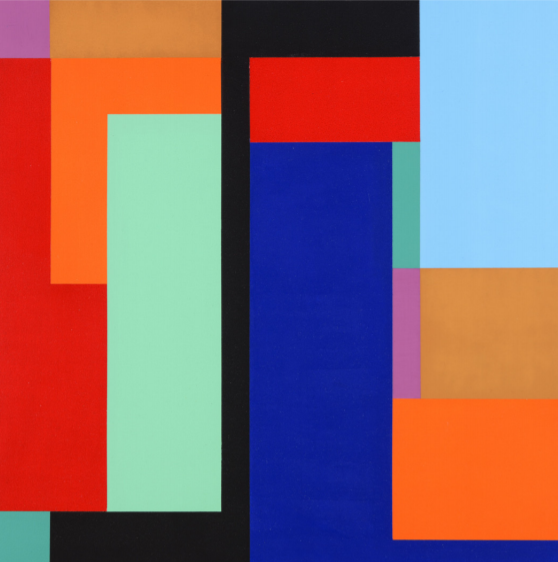DFH63 and Drago Hrvacki’s geometric world
Drago Hrvacki, akademski slikar in eden glavnih predstavnikov neokonstruktivističnih tendenc, je bil 18. januarja 1936 rojen v Ljubljani in umrl 1. februarja 2021. Na likovni akademiji v Ljubljani je od 1958 do 1963 študiral slikarstvo ter grafiko. Po diplomi, leto kasneje, se je študijsko izpopolnjeval še v Italiji. Poučeval je na več različnih šolah, v prostem času se je rad posvečal slikarstvu in deloval kot svobodni umetnik. V slikarstvu, kiparstvu in grafiki se je posvetil geometrični abstrakciji.
Hrvacki izdeluje slike s čistimi in živimi barvnimi ploskvami, ujetimi v pravokotne in geometrične oblike z lepimi ravnimi linijami. Geometrija v slikarstvu je obogatila umetnost in uvedla nove značilnosti ter bistveno drugačne lastnosti. Sliko DFH63 je naslikal leta 2012 s tehniko akrila na lesu in merami 44 x 44 cm. Upodobitev slike je umeščena v brezprostorje, saj ni prisotne tridimenzionalnosti.
Vsebinsko se njegove slike analizirajo drugače, saj neposredno ne izražajo osrednjega motiva ali snovi – konkretno ne predstavlja drugega kot horizontale in vertikale, ki se ločujejo s koti 90°, prav tako ni moč razbrati neposredno spoznavnega motiva. V vsaki sliki se lahko gledalec o sporočilu njegovih abstraktnih del potopi v svojo domišljijo in si predstavlja nekaj povsem svojega.

VIR: DOLŠINA, Marjana. (2015). Katalog Prophetae dommestici. 14. 1. 2021 pridobljeno s: https://xooltime.com/attachments/news_feed/2998222_763732_730005430_Katalog_prophetae_domestici.pdf
»So tudi najbolj pomenljiv del razstave, a odprt in neulovljiv do te mere, da naravnost izzivajo gledalčevo miselno in vsebinski interakcijo«, je zapisala Sandra Bratuša (2010) o pomenu umetnin omenjenega avtorja.
Osebno so mi njegova dela zelo všeč (ker tudi sama obožujem natančnost). Dodelane so v popolnost, brez napak in tako precizno, da sem si lahko predstavljala, kako zelo natančen in perfekcionističen mora umetnik biti. Slike so si med seboj zelo podobne, vendar nobena ni povsem enaka kakšni drugi. Vse barve so skrbno izbrane in tako žive, da pri gledalcu resnično pritegnejo pozornost.
VIRI:
DOLŠINA, Marjana. (2015). Katalog Prophetae dommestici. 14. 1. 2021 pridobljeno s: https://xooltime.com/attachments/news_feed/2998222_763732_730005430_Katalog_prophetae_domestici.pdf
BRATUŠA, Sandra. (2010). Katalog Drago Hrvacki. 14. 1. 2021 pridobljeno s: https://xooltime.com/attachments/news_feed/2998222_763732_449725149_Katalog_drago_hrvacki.pdf
(2019). Geometrija v slikarstvu: lepota jasnih oblik, zgodovina nastanka sloga, umetniki, imena del, razvoj in perspektive. 14.1.2021 pridobljeno s:
AVDIO ZAPIS
BESEDILO: Ema Lavrič, 3.a
Strokovni pregled: Marjana Dolšina Delač
Jezikovni pregled: Nina Papež
Marec 2021
Drago Hrvacki, an academic painter and one of the main representatives of Neoconstructivist tendencies, was born on 18th January 1936 in Ljubljana and died on 1st February 2021. Between the years 1958 and 1963 he studied painting and graphic at the Academy of Fine Arts in Ljubljana. A year after his graduation, he continued his studies in Italy. He taught at many different schools, he dedicated a lot of his free time to painting and he also worked as a freelance artist. In his paintings, sculptures and graphics he focused on geometric abstractions.
Hrvacki’s paintings are created with clean and vivid coloured planes, captured in rectangular and geometric shapes with nice straight lines. Geometry in painting has enriched art and introduced new characteristics and significantly different features. The painting DFH63 was painted in 2012 with the technique acrylic on wood and measures 44 x 44 cm. Depiction of the painting is spaceless, since three-dimensionality is not present.
In terms of content his paintings are analysed differently, as the central motif or subject is not directly expressed– he actually presents horizontal and vertical shapes, separated by 90° angles, and it is also impossible to discern the genre. To understand the message of the artist’s abstract paintings, one can immerse in their own imagination and imagine something unique.
“They’re also the most significant part of the exhibition, but open and elusive to the extent that they directly challenge the viewer’s mental and contextual interaction”, Sandra Bratuša (2010) wrote about the meaning of the pre-mentioned author’s works.
I personally like his artworks, because I also like precision. They are perfect creations, flawless and so precise that I can imagine how accurate and perfectionist the artist had to be. The paintings are very similar, but still, not exactly the same. All the colours are carefully chosen and so vivid, that they really attract the spectator’s attention.
SOURCES
DOLŠINA, Marjana. (2015). Catalogue Prophetae dommestici. Adapted 14 Jan 2021 from: https://xooltime.com/attachments/news_feed/2998222_763732_730005430_Katalog_prophetae_domestici.pdf
BRATUŠA, Sandra. (2010). Katalog Drago Hrvacki. Adapted 14 Jan 2021 from: https://xooltime.com/attachments/news_feed/2998222_763732_449725149_Katalog_drago_hrvacki.pdf
(2019). Geometrija v slikarstvu: lepota jasnih oblik, zgodovina nastanka sloga, umetniki, imena del, razvoj in perspektive. Adapted 14 Jan 2021 from:
AUDIO RECORDING
Text: Ema Lavrič, 3. a
Reviewed by: Nina Papež, Marjana Dolšina Delač
March 2021